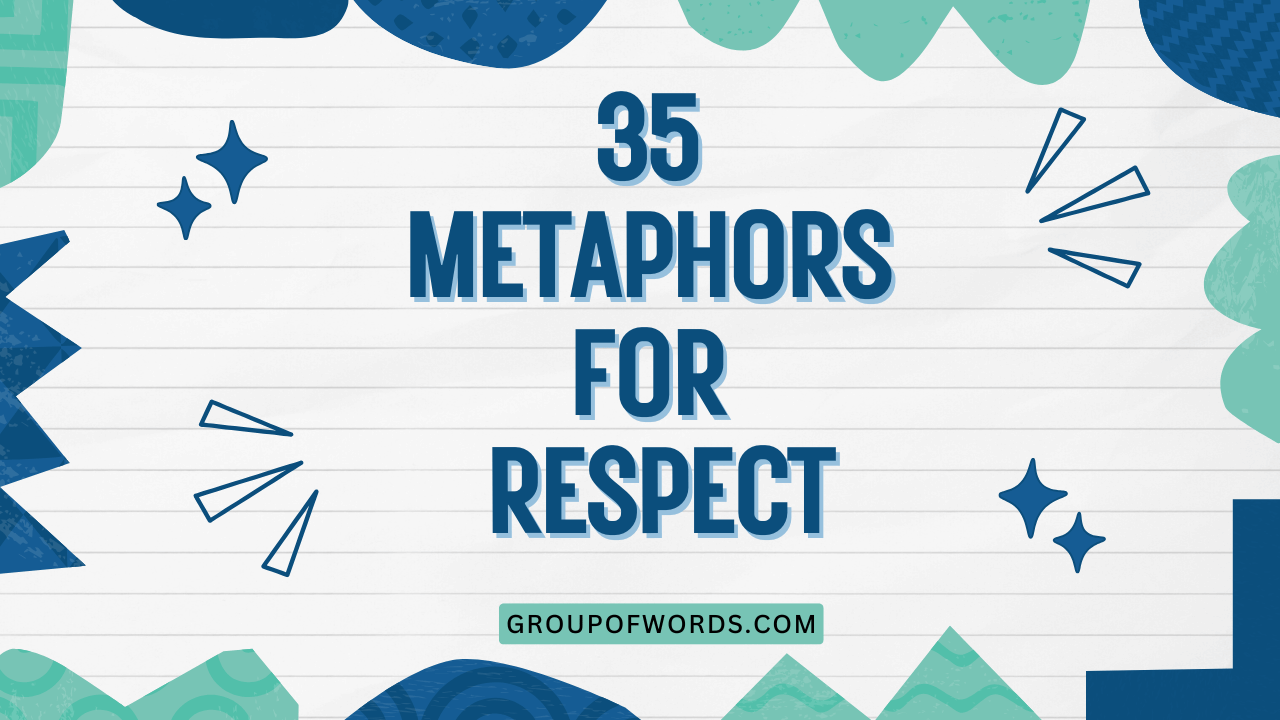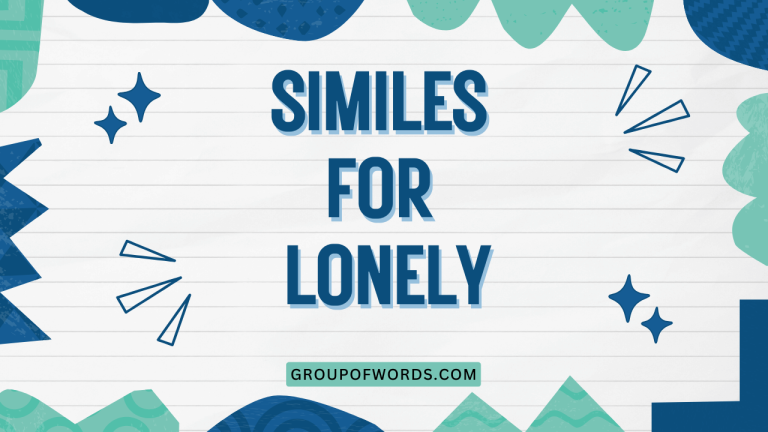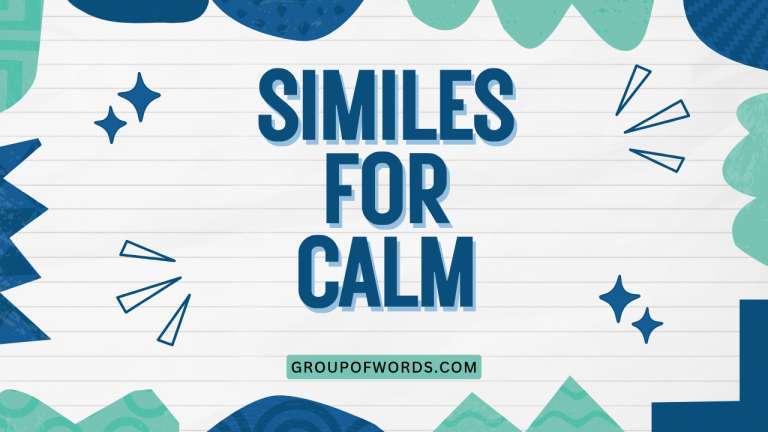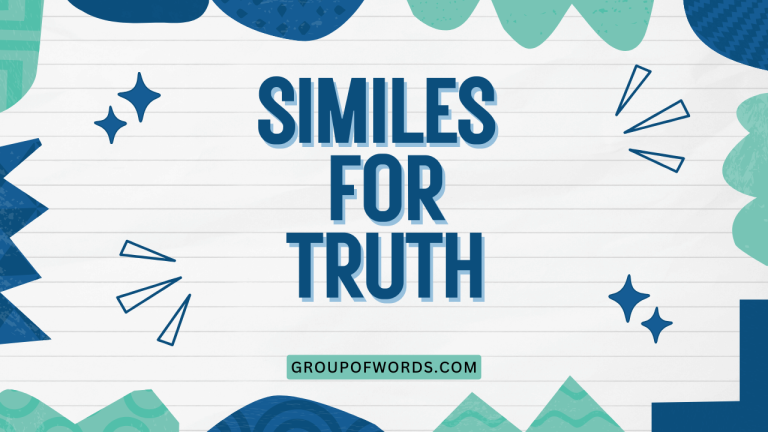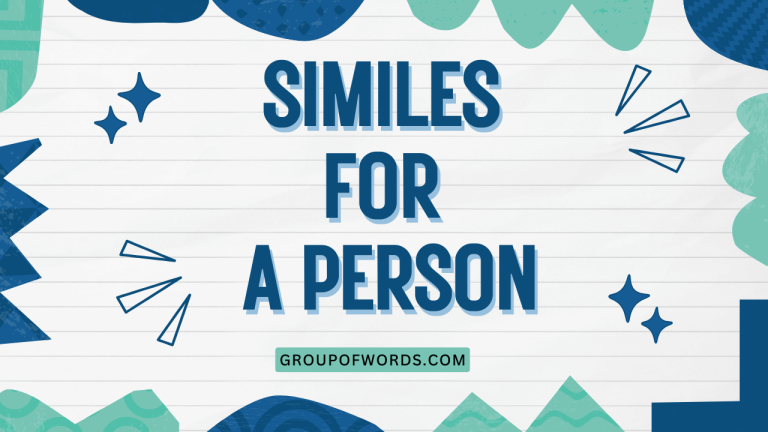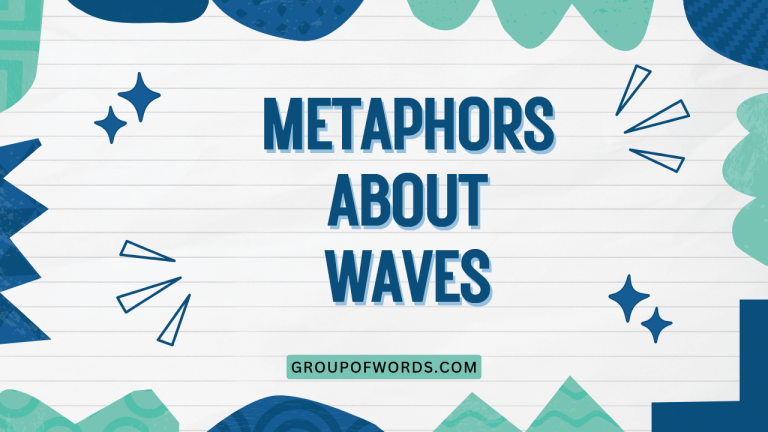35 Metaphors for Respect: Understanding Figurative Language
Understanding metaphors is crucial for mastering the nuances of the English language. Metaphors allow us to express abstract concepts like respect in vivid and relatable terms.
This article provides a comprehensive exploration of 35 metaphors for respect, enhancing your ability to recognize, interpret, and use these figurative expressions effectively. This guide is beneficial for English language learners, writers, and anyone keen on improving their communication skills and appreciating the richness of the English language.
Table of Contents
- Introduction
- Definition of Metaphor and Respect
- Structural Breakdown of Metaphors for Respect
- Types and Categories of Metaphors for Respect
- Examples of Metaphors for Respect
- Usage Rules for Metaphors of Respect
- Common Mistakes When Using Metaphors for Respect
- Practice Exercises
- Advanced Topics: Nuances and Cultural Context
- Frequently Asked Questions
- Conclusion
Definition of Metaphor and Respect
A metaphor is a figure of speech that directly compares two unrelated things, asserting that one thing is another to highlight a shared quality. Unlike similes, which use “like” or “as,” metaphors make a direct comparison. Metaphors enrich language by creating vivid imagery and deeper understanding. They allow us to express abstract concepts in more concrete and relatable ways.
Respect, in this context, is a feeling of deep admiration for someone or something elicited by their abilities, qualities, or achievements. It can also be a feeling of due regard for the feelings, wishes, rights, or traditions of others. Respect involves recognition, appreciation, and often, deference.
Structural Breakdown of Metaphors for Respect
Metaphors for respect typically involve two key elements: the tenor (the subject being described, i.e., respect) and the vehicle (the object or concept used to represent the subject). The connection between the tenor and vehicle is the shared characteristic or quality that the metaphor highlights. Understanding this structure helps in both creating and interpreting metaphors effectively.
For example, in the metaphor “Respect is a bridge,” the tenor is ‘respect,’ and the vehicle is ‘a bridge.’ The shared characteristic is the idea of connection or linking people together. The metaphor suggests that respect connects people, allowing for understanding and communication.
Types and Categories of Metaphors for Respect
Metaphors for respect can be categorized based on the specific aspect of respect they emphasize. Here are five major categories:
Metaphors of Honor and Admiration
These metaphors portray respect as a form of high regard or esteem. They often use imagery of elevation, recognition, or reverence.
Metaphors of Deference and Politeness
These metaphors emphasize the courteous and considerate behavior associated with respect. They often involve imagery of yielding, listening, or accommodating others.
Metaphors of Esteem and Value
These metaphors highlight the perceived worth or importance of the person or thing being respected. They may use imagery of precious objects, strong foundations, or enduring qualities.
Metaphors of Recognition and Acknowledgment
These metaphors focus on acknowledging someone’s achievements, contributions, or existence. They often involve imagery of light, visibility, or clear understanding.
Metaphors of Protection and Care
These metaphors depict respect as a form of safeguarding or nurturing. They often use imagery of shelter, defense, or gentle handling.
Examples of Metaphors for Respect
Here are examples of metaphors for respect, organized by category, to illustrate their diverse applications.
Honor and Admiration Examples
These metaphors highlight the high esteem and regard associated with respect. They often use imagery of elevation or reverence.
The following table provides examples of metaphors that fall under the category of Honor and Admiration. Each example is designed to illustrate the depth and range of this type of metaphorical expression.
| Metaphor | Explanation |
|---|---|
| Respect is a pedestal. | Respect elevates someone, placing them on a high platform. |
| Respect is a crown. | Respect is a symbol of honor and authority. |
| Respect is a standing ovation. | Respect is enthusiastic and public acknowledgment. |
| Respect is a monument. | Respect is a lasting tribute to someone’s achievements. |
| Respect is a salute. | Respect is a formal gesture of admiration. |
| Respect is a laurel wreath. | Symbolizes victory and high achievement. |
| Respect is a hero’s welcome. | Treating someone with great admiration upon their arrival. |
| Respect is a badge of honor. | A mark of distinction and pride. |
| Respect is a throne. | Symbolizes authority and high position. |
| Respect is a golden statue. | Representing someone highly valued and admired. |
| Respect is a victory parade. | Publicly celebrating someone’s achievements. |
| Respect is a raised flag. | Symbolizing honor and high regard. |
| Respect is a spotlight. | Highlighting someone’s accomplishments. |
| Respect is a fanfare. | Announcing someone with great honor. |
| Respect is a royal decree. | Formal recognition of someone’s importance. |
| Respect is a championship trophy. | Symbolizing excellence and achievement. |
| Respect is a distinguished medal. | Awarded for exceptional merit. |
| Respect is a guard of honor. | A ceremonial escort showing high regard. |
| Respect is a national holiday. | Celebrating someone’s contributions. |
| Respect is a standing tribute. | Publicly honoring someone’s legacy. |
| Respect is a hall of fame induction. | Acknowledging lasting impact and greatness. |
| Respect is a scholar’s award. | Recognizing academic excellence. |
| Respect is a general’s commission. | Granting high authority and trust. |
| Respect is a monument dedication. | Honoring someone with a permanent memorial. |
| Respect is a lifetime achievement award. | Recognizing significant contributions over a career. |
Deference and Politeness Examples
These metaphors emphasize the courteous and considerate behavior associated with respect. They often involve imagery of yielding or listening.
The following table provides examples of metaphors that fall under the category of Deference and Politeness. Each example illustrates how respect is shown through courteous and considerate actions.
| Metaphor | Explanation |
|---|---|
| Respect is an open ear. | Respect involves actively listening to others. |
| Respect is a bowed head. | Respect is a gesture of humility and acknowledgment. |
| Respect is a gentle hand. | Respect involves treating others with care and consideration. |
| Respect is a quiet voice. | Respect involves speaking softly and considerately. |
| Respect is a yielding path. | Respect involves making way for others. |
| Respect is a silent nod. | Acknowledging someone’s opinion without interruption. |
| Respect is a lowered gaze. | Showing humility and attentiveness. |
| Respect is a patient pause. | Allowing others to speak without rushing them. |
| Respect is a soft tone. | Speaking in a gentle and considerate manner. |
| Respect is a careful step. | Avoiding actions that might offend others. |
| Respect is a considerate question. | Asking questions mindful of the other person’s feelings. |
| Respect is a thoughtful gesture. | Performing actions that show consideration for others. |
| Respect is a polite request. | Making requests in a courteous and respectful manner. |
| Respect is a gracious acceptance. | Receiving gifts or compliments with gratitude. |
| Respect is a kind word. | Speaking with kindness and empathy. |
| Respect is a courteous reply. | Responding politely and thoughtfully. |
| Respect is a gentle suggestion. | Offering advice in a non-imposing way. |
| Respect is a considerate silence. | Knowing when not to speak to avoid causing offense. |
| Respect is a thoughtful approach. | Addressing situations with care and consideration. |
| Respect is a polite inquiry. | Asking questions with respect for privacy. |
| Respect is a gracious deference. | Yielding to someone else’s wishes politely. |
| Respect is a humble demeanor. | Conducting oneself with humility. |
| Respect is a considerate departure. | Leaving a situation without causing disruption. |
| Respect is a polite refusal. | Declining an offer without causing offense. |
| Respect is a thoughtful acknowledgement. | Recognizing someone’s contributions with gratitude. |
Esteem and Value Examples
These metaphors highlight the perceived worth or importance of the person or thing being respected. They may use imagery of precious objects or strong foundations.
The following table provides examples of metaphors that fall under the category of Esteem and Value. Each example illustrates how respect is associated with high regard and appreciation.
| Metaphor | Explanation |
|---|---|
| Respect is a diamond. | Respect is precious and highly valued. |
| Respect is a cornerstone. | Respect is a fundamental and essential element. |
| Respect is a strong foundation. | Respect provides stability and support. |
| Respect is a priceless artifact. | Respect is irreplaceable and deeply treasured. |
| Respect is a rare gem. | Respect is unique and difficult to find. |
| Respect is a solid oak. | Symbolizing strength, durability, and value. |
| Respect is a golden rule. | The most important principle to follow. |
| Respect is a treasured heirloom. | Something valuable passed down through generations. |
| Respect is a valuable asset. | An important and worthwhile quality. |
| Respect is a precious metal. | Highly valued and essential. |
| Respect is a sturdy pillar. | Providing essential support and strength. |
| Respect is a cherished principle. | A deeply valued and important belief. |
| Respect is a prized possession. | Something highly valued and carefully guarded. |
| Respect is a significant investment. | Worth the effort and resources. |
| Respect is a rich heritage. | A valuable legacy to uphold. |
| Respect is a fine tapestry. | Intricately woven and highly valued. |
| Respect is a sacred vow. | A deeply important and unbreakable promise. |
| Respect is a vital ingredient. | Essential for success and harmony. |
| Respect is a key component. | A necessary element for a functioning system. |
| Respect is a fundamental value. | A core belief that guides behavior. |
| Respect is a moral compass. | Guiding decisions and actions. |
| Respect is a noble virtue. | A highly desirable and admirable quality. |
| Respect is a hallmark of excellence. | A sign of superior quality. |
| Respect is a badge of integrity. | A symbol of honesty and strong moral principles. |
| Respect is a foundation of trust. | Essential for building strong relationships. |
Recognition and Acknowledgement Examples
These metaphors focus on acknowledging someone’s achievements, contributions, or existence. They often involve imagery of light or clear understanding.
The following table provides examples of metaphors that fall under the category of Recognition and Acknowledgment. Each example illustrates how respect is shown through recognizing and acknowledging someone’s worth.
| Metaphor | Explanation |
|---|---|
| Respect is a spotlight. | Respect brings attention to someone’s achievements. |
| Respect is a clear lens. | Respect allows us to see someone’s true worth. |
| Respect is an open book. | Respect involves understanding someone’s story. |
| Respect is a guiding star. | Respect acknowledges someone’s leadership. |
| Respect is a beacon of light. | Respect highlights someone’s positive qualities. |
| Respect is a raised hand. | Acknowledging someone’s presence and contribution. |
| Respect is a clear mirror. | Reflecting someone’s true value and potential. |
| Respect is an open door. | Providing opportunities for growth and recognition. |
| Respect is a listening ear. | Paying attention to someone’s thoughts and feelings. |
| Respect is a seeing eye. | Recognizing someone’s unique qualities. |
| Respect is a known name. | Acknowledging someone’s reputation and accomplishments. |
| Respect is a public record. | Documenting someone’s contributions for posterity. |
| Respect is a celebrated milestone. | Honoring significant achievements. |
| Respect is a marked presence. | Recognizing someone’s impact on a situation. |
| Respect is a visible contribution. | Acknowledging someone’s tangible contributions. |
| Respect is a recognized talent. | Appreciating someone’s skills and abilities. |
| Respect is a noted achievement. | Highlighting someone’s accomplishments. |
| Respect is a documented success. | Providing evidence of someone’s achievements. |
| Respect is a celebrated legacy. | Honoring someone’s lasting impact. |
| Respect is a well-known fact. | Acknowledging someone’s established reputation. |
| Respect is a familiar face. | Recognizing someone’s presence and contributions. |
| Respect is a remembered voice. | Valuing someone’s opinions and insights. |
| Respect is a highlighted passage. | Emphasizing someone’s important contributions. |
| Respect is a cited reference. | Acknowledging someone’s influence on your work. |
| Respect is a credited source. | Giving someone due recognition for their contributions. |
Protection and Care Examples
These metaphors depict respect as a form of safeguarding or nurturing. They often use imagery of shelter or gentle handling.
The following table provides examples of metaphors that fall under the category of Protection and Care. Each example illustrates how respect is shown through safeguarding and nurturing someone’s well-being.
| Metaphor | Explanation |
|---|---|
| Respect is a shield. | Respect protects someone from harm. |
| Respect is a warm blanket. | Respect provides comfort and security. |
| Respect is a safe harbor. | Respect offers a place of refuge. |
| Respect is a gentle embrace. | Respect provides comfort and support. |
| Respect is a watchful eye. | Respect involves looking out for someone’s well-being. |
| Respect is a sheltering tree. | Providing protection and support. |
| Respect is a caring hand. | Offering assistance and support. |
| Respect is a comforting word. | Providing solace and reassurance. |
| Respect is a protective barrier. | Safeguarding someone from harm. |
| Respect is a supportive shoulder. | Offering emotional support. |
| Respect is a secure foundation. | Providing stability and safety. |
| Respect is a nurturing environment. | Fostering growth and well-being. |
| Respect is a guarded secret. | Protecting someone’s privacy. |
| Respect is a defended boundary. | Respecting personal limits. |
| Respect is a nurtured spirit. | Encouraging and supporting someone’s growth. |
| Respect is a safe space. | Providing a secure and non-judgmental environment. |
| Respect is a gentle touch. | Handling someone with care and consideration. |
| Respect is a comforting presence. | Providing reassurance and support. |
| Respect is a protective arm. | Shielding someone from harm. |
| Respect is a loving gesture. | Showing affection and care. |
| Respect is a compassionate heart. | Showing empathy and understanding. |
| Respect is a tender moment. | Cherishing someone’s feelings and needs. |
| Respect is a supportive community. | Providing a network of care and encouragement. |
| Respect is a defended right. | Protecting someone’s freedoms and entitlements. |
| Respect is a nurtured dream. | Encouraging and supporting someone’s aspirations. |
Usage Rules for Metaphors of Respect
Using metaphors effectively requires careful consideration of context and audience. Here are some guidelines:
- Clarity: Ensure the metaphor is understandable and relevant to the context.
- Consistency: Avoid mixing metaphors that create conflicting imagery.
- Appropriateness: Choose metaphors that align with the tone and formality of the situation.
- Originality: Strive for fresh and creative metaphors to make your writing more engaging.
Common Mistakes When Using Metaphors for Respect
Here are some common errors to avoid when using metaphors for respect:
- Mixed Metaphors: Combining unrelated images that create confusion.
- Clichéd Metaphors: Using overused metaphors that lack impact.
- Inappropriate Tone: Employing metaphors that are too informal or disrespectful for the context.
- Lack of Clarity: Using metaphors that are too abstract or difficult to understand.
Examples of Incorrect vs. Correct Usage:
| Incorrect | Correct | Explanation |
|---|---|---|
| “He drowned in a sea of respect, but also stood on a pedestal.” | “He stood on a pedestal of respect.” | Avoid mixing metaphors (drowning and standing). |
| “Respect is a two-way street.” | “Respect is a bridge.” | Avoid clichéd metaphors; opt for more original expressions. |
| “Yo, respect is totally rad, dude!” | “Respect is a fundamental value.” | Use language appropriate for the context and audience. |
| “Respect is a quantum entanglement of existential paradigms.” | “Respect is a deep admiration.” | Ensure the metaphor is clear and easily understood. |
Practice Exercises
Test your understanding of metaphors for respect with these exercises:
Exercise 1: Identifying Metaphors
Identify the metaphor in each sentence and explain its meaning.
| No. | Sentence | Answer |
|---|---|---|
| 1 | Respect is the cornerstone of our community. | Metaphor: Cornerstone. Meaning: Respect is a fundamental and essential element. |
| 2 | Her respect was a warm blanket on a cold day. | Metaphor: Warm blanket. Meaning: Respect provided comfort and security. |
| 3 | His respect was a shield against criticism. | Metaphor: Shield. Meaning: Respect protected him from harm. |
| 4 | Respect for elders is a golden rule in their family. | Metaphor: Golden rule. Meaning: Respect is the most important principle. |
| 5 | Her achievements were bathed in the spotlight of respect. | Metaphor: Spotlight. Meaning: Respect brought attention to her accomplishments. |
| 6 | The judge’s respect for the law was a guiding star for the court. | Metaphor: Guiding star. Meaning: Respect acknowledged the law’s leadership and importance. |
| 7 | His quiet respect was an open ear for her concerns. | Metaphor: Open ear. Meaning: Respect involved actively listening to her. |
| 8 | The team’s respect for their coach was a sturdy pillar of their success. | Metaphor: Sturdy pillar. Meaning: Provided essential support and strength. |
| 9 | Her respect was a beacon of light, highlighting his positive qualities. | Metaphor: Beacon of light. Meaning: Respect highlighted positive qualities. |
| 10 | His respect was a sheltering tree, offering protection and support. | Metaphor: Sheltering tree. Meaning: Providing protection and support. |
Exercise 2: Completing Metaphors
Complete the following sentences by adding a suitable metaphor for respect.
| No. | Sentence | Answer |
|---|---|---|
| 1 | Respect is like ____________, precious and valuable. | Answer: a diamond |
| 2 | For them, respect is ____________, something to be treasured. | Answer: a priceless artifact |
| 3 | Showing respect is like offering ____________ to someone. | Answer: a warm blanket |
| 4 | In their culture, respect for tradition is ____________. | Answer: a cornerstone. |
| 5 | Earning their respect is like winning ____________. | Answer: a championship trophy |
| 6 | His respect for her was like ____________, always present and supportive. | Answer: a supportive shoulder |
| 7 | Her respect for the environment is ____________ for future generations. | Answer: a safe harbor |
| 8 | Their respect for diversity is ____________ in their community. | Answer: a welcoming hand |
| 9 | His respect for knowledge is ____________ that guides his path. | Answer: a guiding star |
| 10 | Her respect for others is ____________ that makes her a great leader. | Answer: a nurturing environment |
Exercise 3: Creating Metaphors
Create your own metaphor for respect based on the given categories.
| No. | Category | Your Metaphor |
|---|---|---|
| 1 | Honor and Admiration | Answer: Respect is a hero’s welcome, celebrating their bravery and sacrifice. |
| 2 | Deference and Politeness | Answer: Respect is a gentle hand, offering assistance without intrusion. |
| 3 | Esteem and Value | Answer: Respect is a solid oak, standing strong and enduring through time. |
| 4 | Recognition and Acknowledgment | Answer: Respect is a spotlight, illuminating their contributions to the world. |
| 5 | Protection and Care | Answer: Respect is a safe harbor, providing refuge from life’s storms. |
| 6 | Honor and Admiration | Answer: Respect is a distinguished medal, awarded for exceptional service and dedication. |
| 7 | Deference and Politeness | Answer: Respect is a courteous reply, acknowledging their perspective with grace and understanding. |
| 8 | Esteem and Value | Answer: Respect is a cherished principle, a guiding light that shapes our actions and decisions. |
| 9 | Recognition and Acknowledgment | Answer: Respect is a remembered voice, echoing through history and inspiring future generations. |
| 10 | Protection and Care | Answer: Respect is a compassionate heart, offering empathy and support to those in need. |
Advanced Topics: Nuances and Cultural Context
Metaphors for respect can vary significantly across cultures. Understanding these nuances is crucial for effective cross-cultural communication.
For example, in some cultures, direct eye contact is a sign of respect, while in others, it may be considered disrespectful. Similarly, metaphors involving physical touch may be appropriate in some contexts but offensive in others.
It is important to research and be mindful of cultural norms when using metaphors for respect.
Additionally, the historical context can influence the interpretation of metaphors. A metaphor that was once considered positive may have negative connotations today due to historical events or social changes.
Therefore, it is essential to be aware of the historical background and potential interpretations of metaphors.
Frequently Asked Questions
Here are some frequently asked questions about metaphors for respect:
- What is the difference between a metaphor and a simile?
A metaphor directly compares two things by stating that one thing is another, while a simile uses “like” or “as” to make a comparison. For example, “Respect is a bridge” is a metaphor, whereas “Respect is like a bridge” is a simile.
- Why are metaphors important in language?
Metaphors enrich language by creating vivid imagery, enhancing understanding, and making abstract concepts more relatable. They allow for more creative and engaging communication.
- How can I improve my ability to understand metaphors?
Practice reading widely, paying attention to figurative language, and analyzing the connections between the tenor and vehicle in metaphors. Consider the context and potential meanings.
- What are some common types of metaphors?
Common types of metaphors include personification (giving human qualities to non-human things), synesthesia (blending senses), and extended metaphors (metaphors that are developed over several lines or paragraphs).
- How do cultural differences affect the interpretation of metaphors?
Cultural differences can significantly influence the interpretation of metaphors. What is considered respectful in one culture may be offensive in another. It’s important to be aware of cultural norms and sensitivities.
- Can metaphors be used in formal writing?
Yes, metaphors can be used in formal writing, but they should be used judiciously and with careful consideration of the audience and context. They should enhance understanding and not detract from the clarity of the writing.
- What should I do if I don’t understand a metaphor?
If you don’t understand a metaphor, try to break it down into its component parts: the tenor and the vehicle. Consider the shared qualities or characteristics that the metaphor is highlighting. If necessary, consult a dictionary or thesaurus for additional context.
- How can I avoid using clichéd metaphors?
To avoid using clichéd metaphors, try to think creatively and come up with fresh and original comparisons. Use a thesaurus to find alternative words and phrases. Experiment with different types of imagery to create unique metaphors.
Conclusion
Mastering the use of metaphors for respect enhances your ability to communicate effectively and appreciate the richness of the English language. By understanding the different types of metaphors, their structural elements, and usage rules, you can express complex ideas in vivid and engaging ways.
Remember to consider the context, audience, and cultural nuances when using metaphors to ensure clarity and appropriateness. Continue practicing and exploring new metaphors to refine your skills and deepen your understanding of figurative language.
